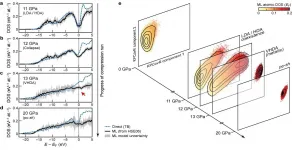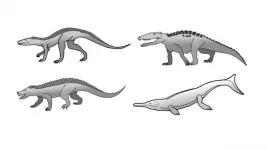Response to infection therapy better understood thanks to a new technique
A sequencing-based solution can be utilised to determine infection clearance and microbiota recovery. Next, the researchers will apply the technique to investigate the coronavirus disease
2021-01-07
(Press-News.org) Infectious diseases are caused by pathogenic viruses, bacteria, fungi or parasites. The treatment of bacterial and fungal infections relies particularly on antimicrobial drugs, while the focus in treating viral infections is the alleviation of symptoms.
Initial therapy for infection is often empiric and guided by clinical presentation. Its efficacy on the pathogen is, however, only seldom understood at therapy initiation. Although methods for assessing treatment responses exist, the effectiveness is mainly determined through monitoring symptoms and signs of infections.
Advances in sequencing technology have made characterization of genomes and gene expression products increasingly practical. The technology has also made it possible to identify microbiota components up to species- and gene-level. Nevertheless, microbiota sequencing is only occasionally employed in infection treatment.
Now, researchers at the University of Helsinki have, together with their collaborators at the Helsinki University Hospital, developed a new sequencing-based approach for pathogen discovery from challenging samples. The approach and preliminary results on its usage in burn wound infection clearance assessment have been published in the Clinical Microbiology and Infection journal.
"The approach enables to capture the real-time functional activities of even minuscule amounts of microbes. It can be used to reliably investigate the activity of microbial drug resistance mechanisms and other microbial mechanisms relevant to infection or its treatment. This helps to understand whether causative microbes are alive or dying and what they do," says bioinformatician Matti Kankainen, PhD, from the University of Helsinki.
Technique sheds light on pathogen activities
The underlying principle of the technique is as follows: a clinical sample is taken from the patient and its RNA, the underlying foundation of biological processes, is extracted. Next, the microbial RNA is enriched to magnify pathogen information. The RNA is sequenced and the extensive amounts of data gained are analysed by novel algorithms.
To understand the value of the approach in clinical practice, the researchers applied their solution to a complicated wound infection case. The study subject was a wound infection patient that had been treated with several antibiotic therapies for almost one hundred days unsuccessfully. In spite of the therapies, the infection recurred. Briefly following the start of the fourth antibiotic regimen, the researchers collected samples from the infection site. The samples were analysed using their approach as well as with the help of the more common 16S DNA-gene profiling. Corresponding samples were collected also from a control subject.
The fourth antibiotic regimen proved to be effective and alleviated symptoms. The results gained using the new approach agreed the clinical presentation and confirmed the elimination of the pathogen. Furthermore, they demonstrated the recovery of the normal microbiota. A similar microbiota change was not seen in the 16S profiling. Instead, candidate pathogens of the infection were identified, due to the slow breakdown of DNA.
Metatranscriptomics may be the answer to diagnosing infectious diseases
The used approach is known as metatranscriptomics. It allows the comprehensive determination of microbial gene activity. Its use has become increasingly prevalent, but problems related to handling and analysis of challenging host-microbe samples have prevented the more widespread clinical use of metatranscriptomics.
"Our findings demonstrate that our solution suits also to challenging samples that contain minuscule amounts of microbes. On top of pathogen identification, it can be used to characterise host-microbe interaction. It may thereby shed light into yet-unidentified disease mechanisms. We will develop the technique further as a part of infection studies ongoing at our laboratory. Further work will also focus on understanding its application spectrum," says Esko Kankuri, docent in pharmacology at the University of Helsinki.
Postdoctoral Researcher Teija Ojala from the University of Helsinki developed the new approach. Next, Ojala will utilise the technique to advance our understanding on COVID-19 coronavirus disease.
INFORMATION:
ELSE PRESS RELEASES FROM THIS DATE:
2021-01-07
Combining electronic structure calculations and machine learning (ML) techniques has become a common approach in the atomistic modelling of matter. Using the two techniques together has allowed researchers, for instance, to create models that use atomic coordinates as the only inputs to inexpensively predict any property that can be computed by the first-principles calculations that had been used to train them.
While the earliest and by now most advanced efforts have focused on using predictions of total energies and atomic forces to construct interatomic potentials, more recent efforts have targeted additional properties of crystals and molecules such as ionization energies, NMR chemical shieldings, dielectric response properties and charge density. In the paper "Learning ...
2021-01-07
It is during rare merging events that galaxies undergo dramatic changes in their appearance and in their stellar content. These systems are excellent laboratories to trace the formation of star clusters under extreme physical conditions.
The Milky Way typically forms star clusters with masses that are 10 thousand times the mass of our Sun. This doesn't compare to the masses of the star clusters forming in colliding galaxies, which can reach millions of times the mass of our Sun.
These dense stellar systems are also very luminous. Even after the collision, when the resulting galactic system begins to fade into a more quiescent phase, these very massive star clusters will shine throughout their host galaxy, as long-lasting witnesses of past merging events.
By studying the six galaxy ...
2021-01-07
Autoimmune diseases are diseases of "mistaken identity", where the immune system - which is supposed to protect us against infectious diseases and neoplasias - mistakenly attacks and destroys components of our own body. The incidence of autoimmune diseases is increasing on a worldwide basis, and these diseases - including type 1 diabetes (T1D), systemic lupus erythematosus (SLE), multiple sclerosis (MS) and rheumatoid arthritis (RA) - now affect up to 5% of the population in different regions. There is no cure for autoimmune diseases, and while the immune target of T1D, SLE, MS, and RA are distinct, they share several similar elements, including up to 50% common genetic risk, chronic local inflammation and mechanisms ...
2021-01-07
Researchers at the University of Gothenburg now suggest a possible cure for children with hard-to-treat forms of neuroblastoma using a new combination of drugs. In a new study in the journal Cancer Research, they describe how a two small molecule-based drug combination likely inhibit the tumor's growth.
Neuroblastoma is the most common form of childhood cancer, derived from the peripheral nervous system, i.e., the part of the nervous system that is not the brain or spinal cord. The disease can occur in the chest, neck, abdomen and adrenal glands and can also spread to the spine. Symptoms include general aches, anemia and skeletal pain.
The ...
2021-01-07
Stomach cancer, or gastric cancer, is a common gastrointestinal malignancy. Peritoneal metastasis occurs in a majority of patients with advanced stomach cancer and is considered as an aggressive disease with poor outcomes.
Patients with peritoneal metastasis are typically not eligible for curative surgery. Therefore, preoperative detection and diagnosis of peritoneal metastasis are critical to inform treatment decision-making and avoid unnecessary surgery.
A new study published in the JAMA Network Open on Jan. 5 shows that deep learning can help predicting the occult peritoneal metastasis in stomach cancer. It provides a novel and noninvasive approach for ...
2021-01-07
Olduvai (now Oldupai) Gorge, known as the Cradle of Humankind, is a UNESCO World Heritage site in Tanzania, made famous by Louis and Mary Leakey. New interdisciplinary field work has led to the discovery of the oldest archaeological site in Oldupai Gorge as reported in Nature Communications, which shows that early human used a wide diversity of habitats amidst environmental changes across a 200,000 year-long period.
Located in the heart of eastern Africa, the Rift System is a prime region for human origins research, boasting extraordinary records of extinct human species and environmental records spanning several million years. For more than a century, archaeologists and human palaeontologists have been exploring the East African Rift outcrops and unearthing hominin fossils in surveys ...
2021-01-07
New research by scientists at the University of Bristol explains how a 'stop-start' pattern of evolution, governed by environmental change, could explain why crocodiles have changed so little since the age of the dinosaurs.
Crocodiles today look very similar to ones from the Jurassic period some 200 million years ago. There are also very few species alive today - just 25. Other animals such as lizards and birds have achieved a diversity of many thousands of species in the same amount of time or less.
Prehistory also saw types of crocodile we don't see today, including giants as big as dinosaurs, plant-eaters, fast ...
2021-01-07
Scientists at the University of Birmingham, UK, have shown that a novel low molecular weight dextran-sulphate, ILB® could play a key role in treating open angle glaucoma (OAG), a neurodegenerative disease that affects over 70 million people worldwide and causes irreversible blindness.
OAG develops slowly over many years. Excessive matrix deposition (fibrosis) within the eye's main fluid drainage site can lead to increased intraocular pressure (IOP), resulting in damage to the optic nerve.1
The research, reported in npj Regenerative Medicine, has ...
2021-01-07
The North Sea is a heavily trafficked area, with major shipping routes crossing its waters, and fisheries, offshore oil rigs, and wind farms populating its waves. All this activity inevitably has an effect on marine wildlife, and scientists are particularly interested in how the harbor porpoise population has fared in the face of such disturbances.
The harbor porpoise is known as a "sentinel species" - animals which indicate the health of an ecosystem and point to potential risks (think of the canary in the coal mine). According to a recent study published in Frontiers ...
2021-01-07
A new study in the Oxford Economic Papers finds that migration flows the last 500 years from high sunlight regions to low sunlight regions influence contemporary health outcomes in destination countries.
The researchers here noted that people's ability to synthesize vitamin D from sunlight declines with skin pigmentation, and that vitamin D deficiency is directly associated with higher risk of mortality, from illnesses including cardiovascular disease, type 1 and type 2 diabetes, hypertension, and certain cancers. Recent research even .finds that vitamin D affects the severity of COVID-19.
Researchers here focused on ...
LAST 30 PRESS RELEASES:
[Press-News.org] Response to infection therapy better understood thanks to a new technique
A sequencing-based solution can be utilised to determine infection clearance and microbiota recovery. Next, the researchers will apply the technique to investigate the coronavirus disease






